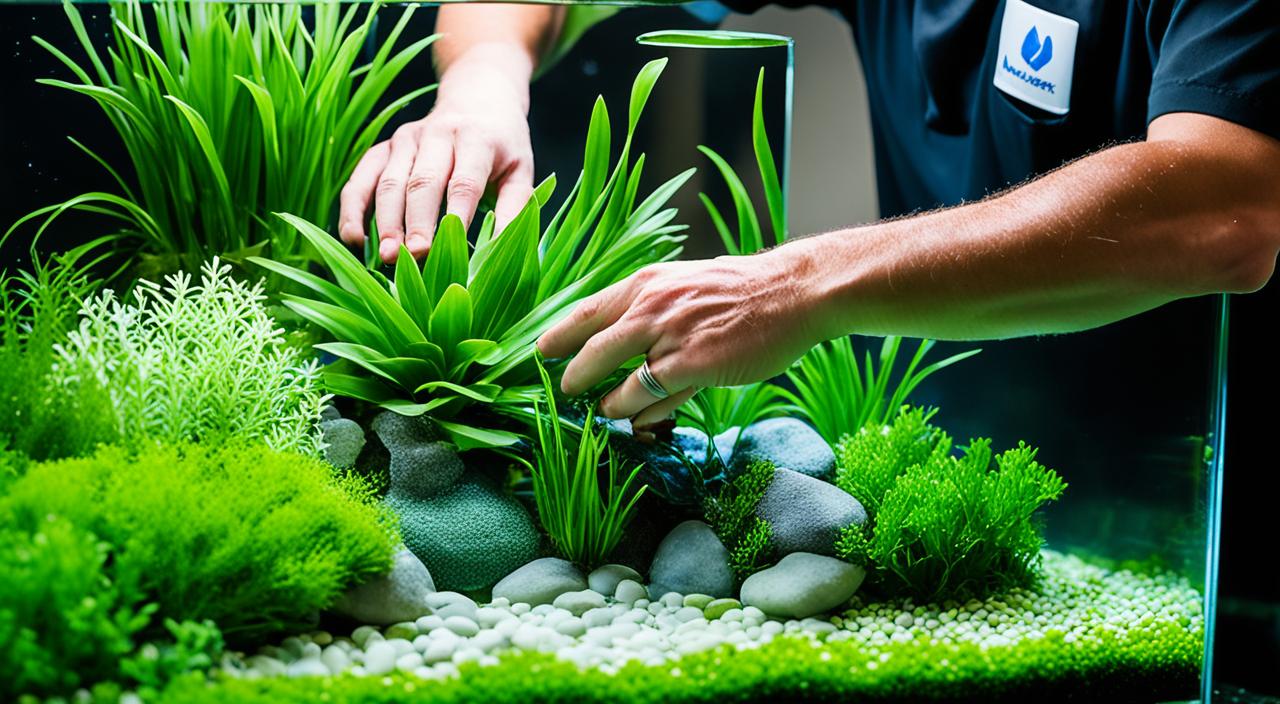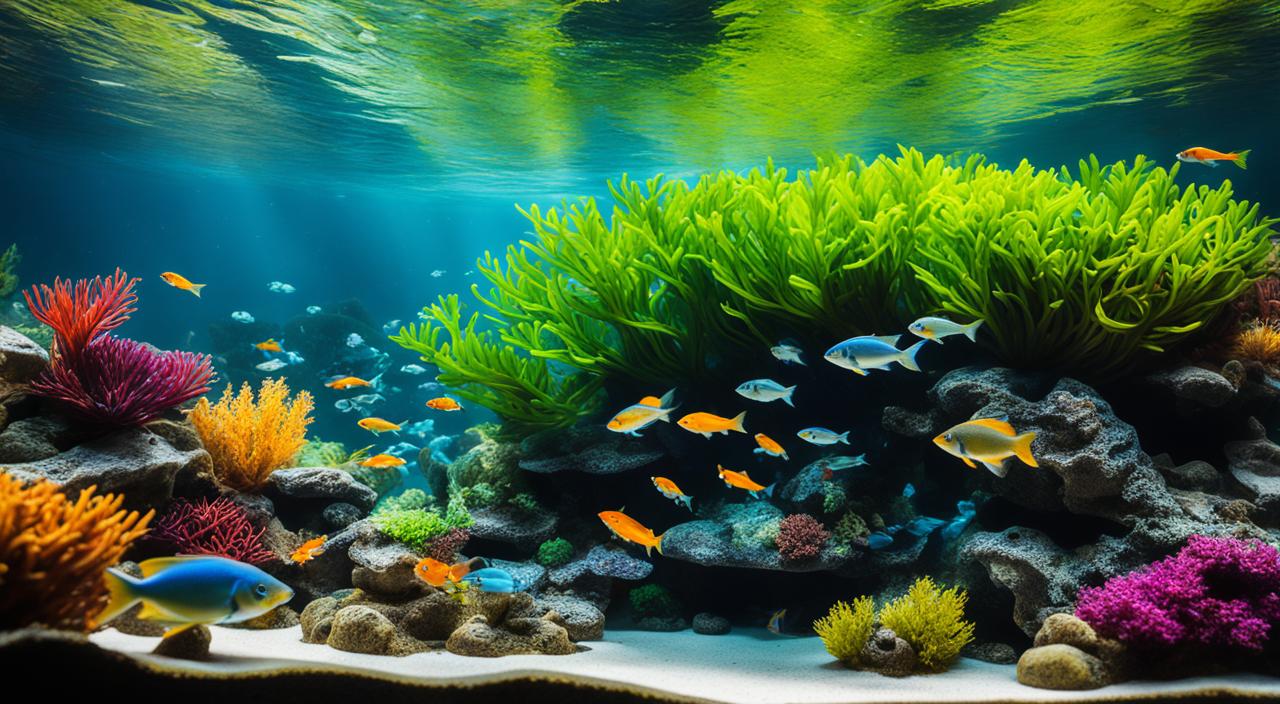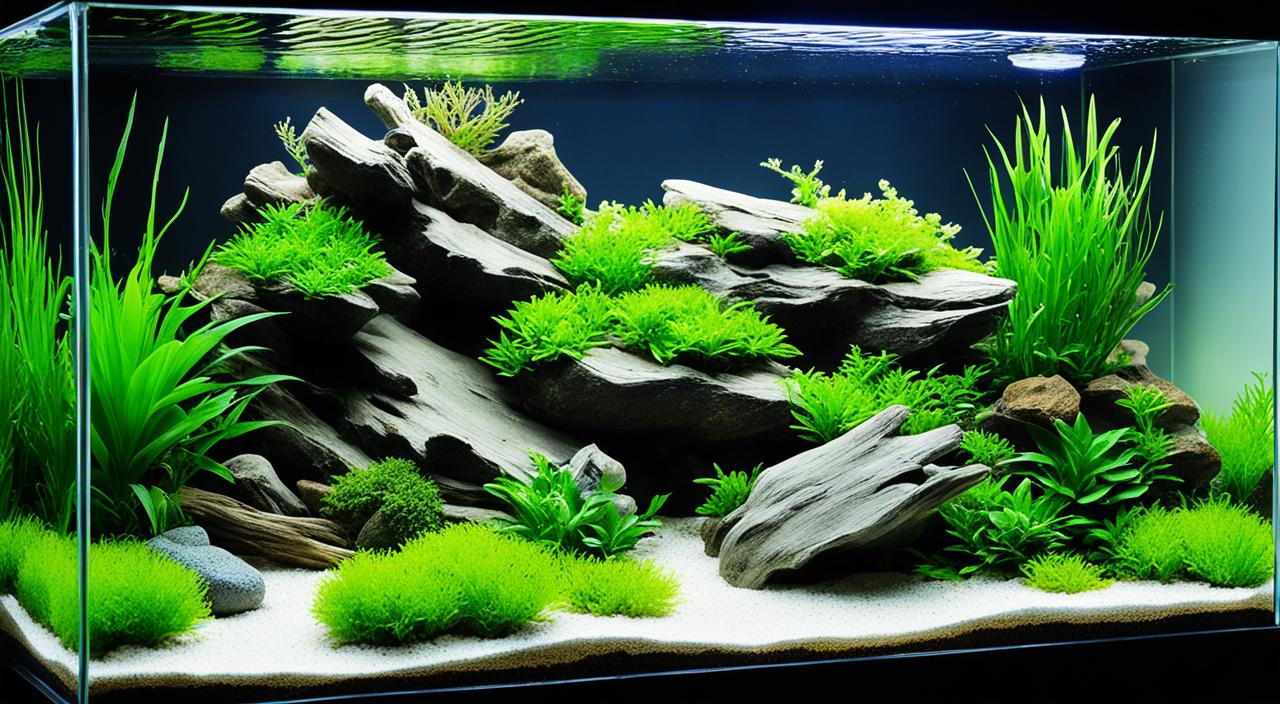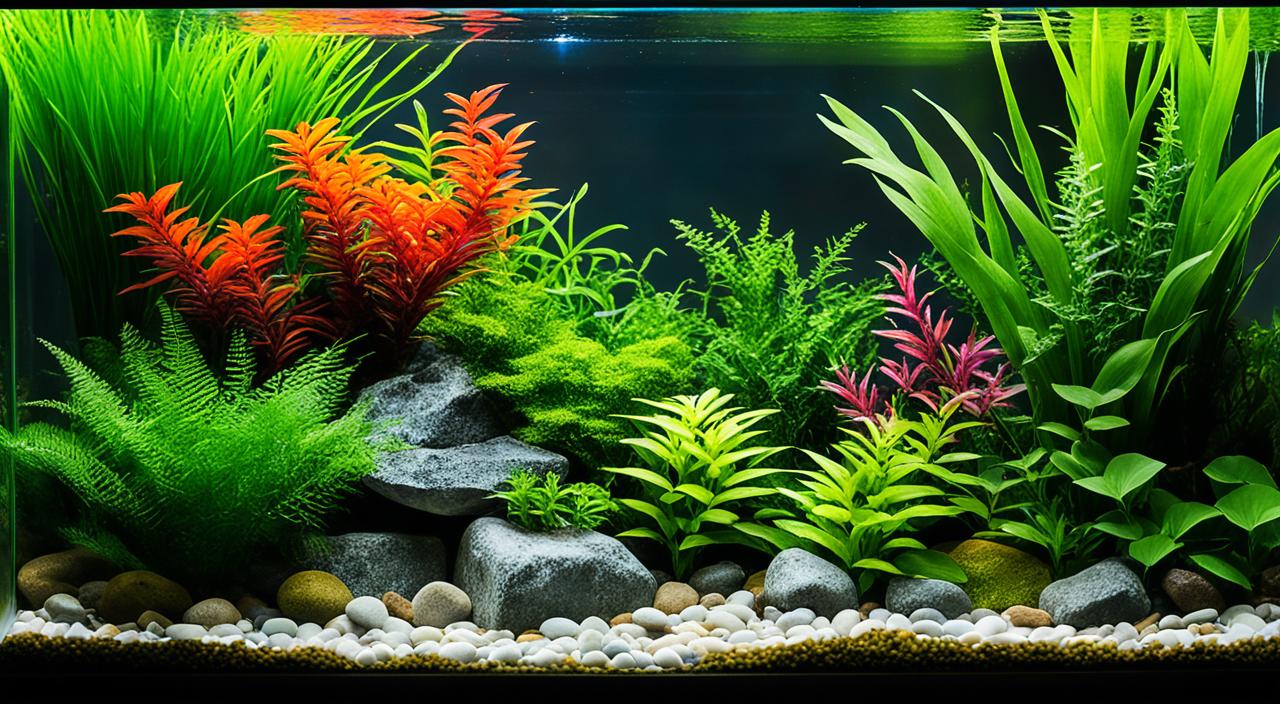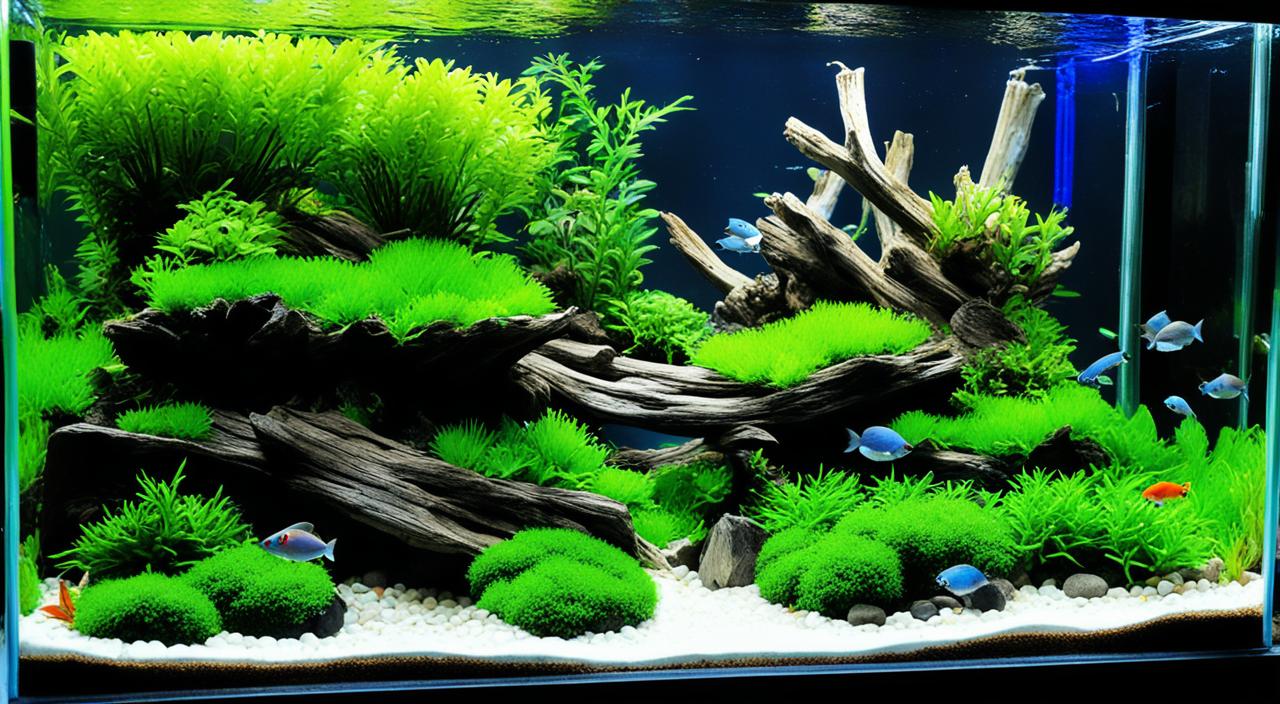When creating stunning underwater landscapes in aquariums, aquascaping is the ultimate art form. It combines the scientific aspects of aquatic horticulture with the creativity of design and layout. To excel in aquascaping, one must understand the basics of this art and master the principles that govern it.
To begin with, simplicity is vital. A harmonious aquascape relies on a clean and uncluttered design. You can achieve a visually pleasing and balanced composition by carefully selecting and arranging aquatic plants, rocks, and other hardscape materials. Variety is also essential, adding interest and depth to the aquascape. Incorporating plants of different sizes, shapes, and colours creates a dynamic and captivating underwater environment.
Proportion plays a crucial role in aquascaping. It is essential to consider each element’s size, shape, and placement to create a visually appealing aquascape. Understanding the rule of thirds and the golden ratio can help achieve a well-balanced layout. Lastly, persistence is needed in aquascaping. It takes time and dedication to establish and maintain a thriving aquatic ecosystem.
Factors such as lighting, water filtration, CO2 supplementation, liquid fertilizers, substrate selection, and hardscaping materials are essential to ensure the health and growth of aquatic plants in an aquascape. You can create a thriving underwater garden that captivates and delights you by providing the right conditions and care.
Key Takeaways:
- Understanding the basic principles of aquascaping, such as simplicity, variety, proportion, and persistence, is crucial for creating a harmonious and visually pleasing aquascape.
- Factors like lighting, water filtration, CO2 supplementation, liquid fertilizers, substrate selection, and hardscaping materials are essential for the health and growth of aquatic plants in an aquascape.
- Carefully considering the placement of hardscape elements and using the rule of thirds and the golden ratio can result in a visually appealing and balanced aquascape layout.
- There are various aquascaping styles to explore, including the Dutch style, Jungle style, Iwagumi style, and Nature style, each with its unique characteristics and features.
- Nano tank aquascaping offers a compact and affordable way to experiment with aquascaping, allowing you to create stunning miniature ecosystems in small aquariums.
Aquascape Layout Planning: The Rule of Thirds and the Golden Ratio
Careful layout planning is essential to create a visually stunning and harmonious underwater landscape when designing an aquascape. Two important principles are the rule of thirds and the golden ratio.
The Rule of Thirds
The rule of thirds is a design principle that suggests dividing the tank into nine equal parts using two horizontal and two vertical lines. This creates a grid-like structure that allows you to strategically place focal points and create visual interest within the aquascape.
By placing key elements such as rocks, driftwood, or eye-catching aquatic plants at the intersection points of these lines, you can draw the viewer’s gaze and create a sense of balance and harmony.
The Golden Ratio
The golden ratio, also known as the divine proportion, is a mathematical concept seen in patterns found in nature and art. Applying the golden ratio to aquascape layout planning helps create a sense of balance and aesthetics.
To apply the golden ratio in your aquascape, consider the proportions of the overall tank dimensions, the placement of hardscape elements, and the arrangement of aquatic plants. By following the ratio of approximately 1.618:1, you can achieve a visually pleasing and balanced composition.
Combining the rule of thirds and the golden ratio in your aquascape layout planning allows you to create a visually appealing and captivating underwater landscape. Harnessing these design principles ensures that your aquascape is aesthetically pleasing and evokes a sense of harmony and natural beauty.
| Rule of Thirds | Golden Ratio |
|---|---|
| Divides tank into nine equal parts | Applies the ratio of approximately 1.618:1 |
| Allows placement of focal points | Creates balance and harmony |
| Creates visual interest | Achieves aesthetically pleasing composition |
Aquascaping Styles: Dutch, Jungle, Iwagumi, and Nature Aquarium
Aquascaping offers a variety of styles, each with unique characteristics and features. Let’s explore the different aquascaping styles: Dutch, Jungle, Iwagumi, and Nature Aquarium.
Dutch Style
The Dutch aquascaping style focuses on the cultivation and arrangement of aquatic plants. It involves creating a visually stunning display of height, colour, and texture using various plants. The Dutch style often features meticulously trimmed and organized plant arrangements, creating a vibrant and lush aquatic garden.
Jungle Style
The Jungle style aims to replicate the untamed appearance of a natural jungle. This style is characterized by dense vegetation and minimal hardscape, with plants growing abundantly and seemingly taking over the entire aquascape. The Jungle style creates a wild and naturalistic look, perfect for those seeking a lush and vibrant underwater jungle.
Iwagumi Style
The Iwagumi aquascaping style emphasizes using rocks as the main hardscape element. The rocks are carefully placed according to the golden ratio, creating balance and harmony within the aquascape. This style often features minimalistic planting, showcasing the rocks’ beauty and elegance.
Nature Aquarium Style
The Nature Aquarium style seeks to balance natural and man-made elements. It aims to recreate natural aquatic ecosystems, incorporating hardscape elements like rocks, driftwood, and carefully selected plants. The Nature style often strives to achieve a harmonious and natural look, resembling a slice of nature captured within an aquarium.
Nano Tank Aquascaping: Small but Mighty
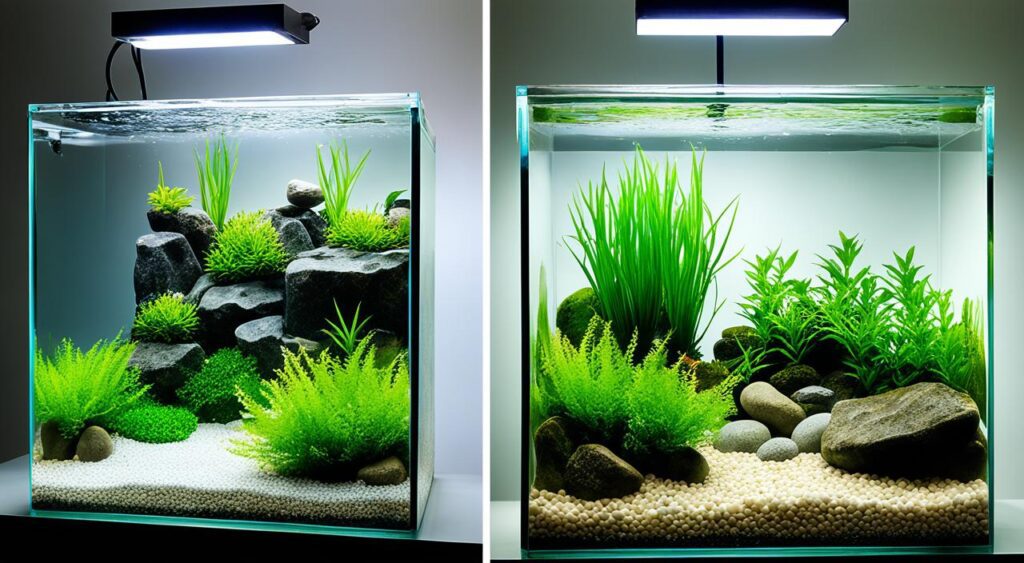
Nano tanks, which hold less than 10 gallons of water, offer a compact and affordable way to explore aquascaping. Despite their small size, nano tanks have the potential to create stunning aquascapes and bring a piece of nature into any living space.
Creativity is vital to designing a nano tank aquascape. You can create a visually appealing and balanced miniature ecosystem using rocks, driftwood, and carefully selected plants. The compact nature of nano tanks allows for intricate and detailed aquascapes that showcase the beauty of aquatic plants and create a sense of tranquillity.
Choosing the Right Equipment and Inhabitants
Choosing appropriate equipment and inhabitants is essential when setting up a nano tank aquascape. Selecting a compact filter, heater, and lighting system that fits the size of your nano tank ensures optimal conditions for plant growth and the well-being of aquatic life.
When selecting inhabitants for your nano tank, consider smaller fish and invertebrates compatible with the tank’s size and water parameters. Research their care requirements and ensure they will thrive in the limited space of a nano tank.
Maintaining a Healthy Nano Tank
Maintaining a healthy nano tank requires regular maintenance. Perform regular water changes to keep the water quality pristine, and monitor the nitrate and phosphate levels to prevent algae growth. Proper nutrient management through liquid fertilizers or substrates enriched with nutrients ensures the healthy growth of aquatic plants.
Pruning and trimming the plants regularly helps maintain their shape and prevents overcrowding. Maintaining a balance between light and dark areas within the tank helps control algae growth. Consider introducing algae-eating species, such as shrimp or snails, to keep algae in check.
The image above showcases the beauty and intricate design possibilities of nano tank aquascaping. With creativity, attention to detail, and proper maintenance, compact aquascapes can transform even the smallest of spaces into a vibrant underwater landscape.
| Benefits of Nano Tank Aquascaping | Challenges of Nano Tank Aquascaping |
|---|---|
|
|
Aquascaping Tips for Beginners
If you’re a beginner looking to dive into aquascaping, here are some helpful tips to start your aquatic gardening journey.
First and foremost, take the time to get to know different aquatic plants and fish species. This knowledge will allow you to make informed choices when selecting the right plants and inhabitants for your aquascape, ensuring compatibility and a thriving ecosystem.
Understanding the basic water parameters and chemistry of your aquarium is also crucial. Maintaining proper water conditions is essential for the health and growth of your aquatic plants and fish. Research and monitor pH levels, temperature, and water hardness to create an optimal environment.
Learning about aquascaping design principles is another valuable tip for beginners. Concepts like the rule of thirds, the golden ratio, and the use of contrast can help you create visually appealing and balanced aquascapes. Experiment with different layouts, focal points, and plant arrangements to find your unique style.
Lastly, remember that aquascaping is a journey that requires patience and practice. Don’t get discouraged if your first attempts don’t happen as planned. Embrace the learning process, learn from your mistakes, and keep experimenting. With time and dedication, you’ll become a master of the art of aquascaping.
FAQ
What is aquascaping?
Aquascaping is the art of underwater gardening, creating visually pleasing landscapes in aquariums. It involves both the scientific aspects of aquatic horticulture and the creative elements of design and layout.
What are the basic principles of aquascaping?
The basic principles of aquascaping include simplicity, variety, proportion, and persistence. These principles help create a harmonious and aesthetically pleasing aquascape.
What are important factors to consider when planning the layout of an aquascape?
When planning the layout of an aquascape, it is important to consider the rule of thirds and the golden ratio. These concepts help create visual interest and achieve a sense of balance and harmony within the aquascape.
What are the different styles of aquascaping?
The different styles of aquascaping include the Dutch style, Jungle style, Iwagumi style, and Nature style. Each style has its own unique characteristics and features.
What is nano tank aquascaping?
Nano tank aquascaping refers to creating aquascapes in small aquariums that hold less than 10 gallons of water. It offers a compact and affordable way to explore aquascaping and create miniature ecosystems.
What are some tips for beginners venturing into aquascaping?
Some tips for beginners venturing into aquascaping include getting to know aquatic plants and fish species, understanding water parameters and chemistry, learning about aquascaping design principles, and being patient and experimenting with the process.
Source Links
- https://sevenports.com/2020/02/20/aquascaping-101-an-aquascaping-technique-guide/
- https://aquascapinglove.com/basics/aquascaping-for-beginners-10-helpful-tips/
- https://www.co2art.us/blogs/blog/h1-data-pm-slice-1-1-data-mce-fragment-1-mastering-the-art-of-aquascaping-the-nano-tank-a-beginners-guide-h1-p-data-mce-fragment-1-nbsp-p

